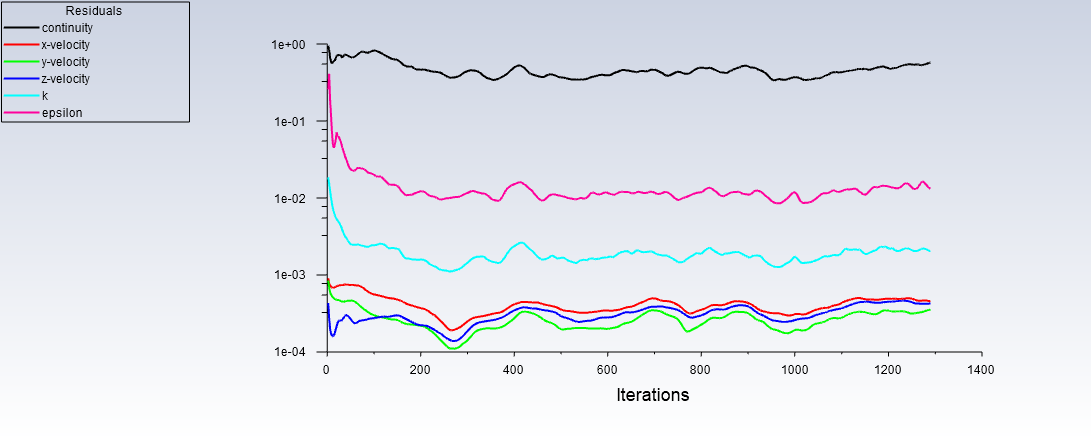-
-
February 12, 2024 at 3:20 pm
Jason Sum
SubscriberNA
-
February 12, 2024 at 4:35 pm
Rob
Forum ModeratorYou're welcome, and thanks for starting a new topic for a new question.
1) Up to you - how high is the building relative to the ABL? What is upstream to decide if the ABL has formed or been chewed up by the scenery?
2) Your monitor shows a roughly repeated variation every 50-ish iterations. Plot velocity contrours around the building every 5 iterations. Also pressure on the building. What do they tell you?
3) How long a transient did you run? Time step was probably well under a second, but what frequency do you expect the flow to change at?
The extra data from 2 & 3 will help you decide if the flow changes enough to need to worry about it. A transient flow may be a very small fluctuation that can be ignored, or a very big change that can't.
-
March 3, 2024 at 4:16 pm
Jason Sum
SubscriberGrateful if you could address my problems down below ????
-
-
March 3, 2024 at 4:13 pm
Jason Sum
SubscriberHi Rob, based on your guidance, I have included the ABL (by UDF) for my building aerodynamics case to account for the roughness of urban terrain at the upstream.

Through a steady-state simulation with ABL inlet, the continuity residual still fluctuated between 1e0 ~ 1e-1 without converging.

As mentioned, BOI refinement made to capture wake and leeward side, Face refinement for building and ground surface
Maximum Aspect Ratio = ~39 (high aspect ratio mostly happen in inflation layers of building edges)
Minimum Orthogonal Quality of: 0.30Mass imbalance and pressure monitored at a point near rooftop (per 5 iter) also did not obtain consistent values as simulation going on. And turbulent viscosity limited to viscosity ratio of 1.000000e+05 without decreasing.


I am confused, in this case should I keep working on improving mesh quality for steady state continuity convergence, OR look for a transient process as the flow phenomenon in this case may be dynamically changing and hardly reaching a steady outcome? Is it possible that no steady state convergence because the building flow and wake oscillate (e.g. shedding)?
Kindly hope for your experienced and comprehensive guide on this, such issue struggled me a lot!! Mush appreciate!
-
March 4, 2024 at 9:57 am
Rob
Forum ModeratorOK, first off the turbulence limiter is there to stop the solver running away, but with urban models whilst the ratio is high the turbulence values aren't, so increasing the limit by 4-5 0s is fine, and something I tend to do before running the model. You'll not find that in the text books!
Now, the flow result. Your domain is big, if you look at the mass imbalance and/or fluctuations and work out how big a velocity variance is required to see that on the outlet how big a change in velocity is there? For a local monitor, wait for a windy day and go and stand outside. How stable is the wind? Ie are you seeing a (non scientific) steady value or are you being buffeted by gusts? Now compare that to what you're seeing in the Fluent model, and think about shedding. But... can you afford to run a full transient, or is the steady solution good enough for what you need? When thinking about that, how confident are you that the building shape is exactly correct (do the windows have frames etc or balconies), did you include trees & cars in the model?
-
- The topic ‘NA’ is closed to new replies.


- air flow in and out of computer case
- Varying Bond model parameters to mimic soil particle cohesion/stiction
- Eroded Mass due to Erosion of Soil Particles by Fluids
- I am doing a corona simulation. But particles are not spreading.
- Centrifugal Fan Analysis for Determination of Characteristic Curve
- Issue to compile a UDF in ANSYS Fluent
- Guidance needed for Conjugate Heat Transfer Analysis for a 3s3p Li-ion Battery
- JACOBI Convergence Issue in ANSYS AQWA
- affinity not set
- Resuming SAG Mill Simulation with New Particle Batch in Rocky

-
4177
-
1487
-
1363
-
1194
-
1021

© 2025 Copyright ANSYS, Inc. All rights reserved.







